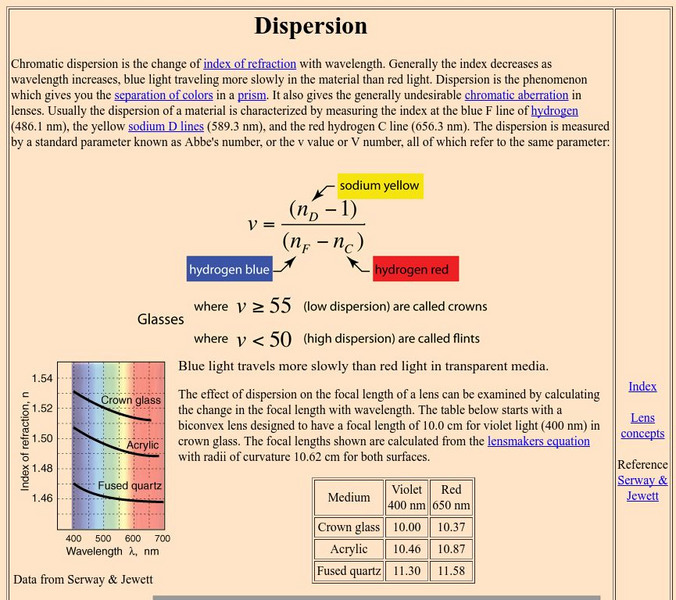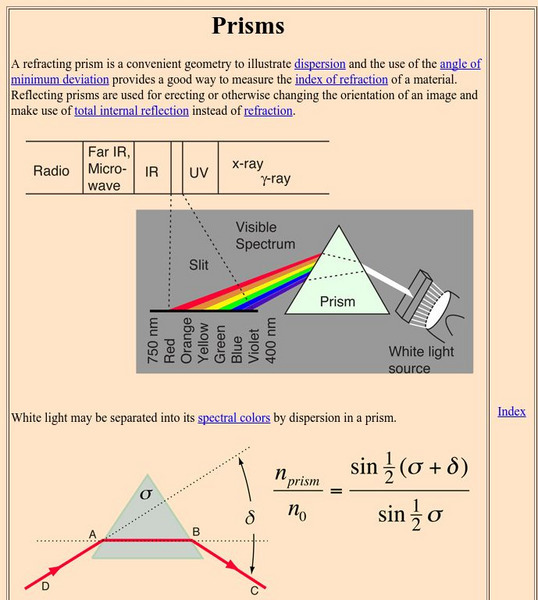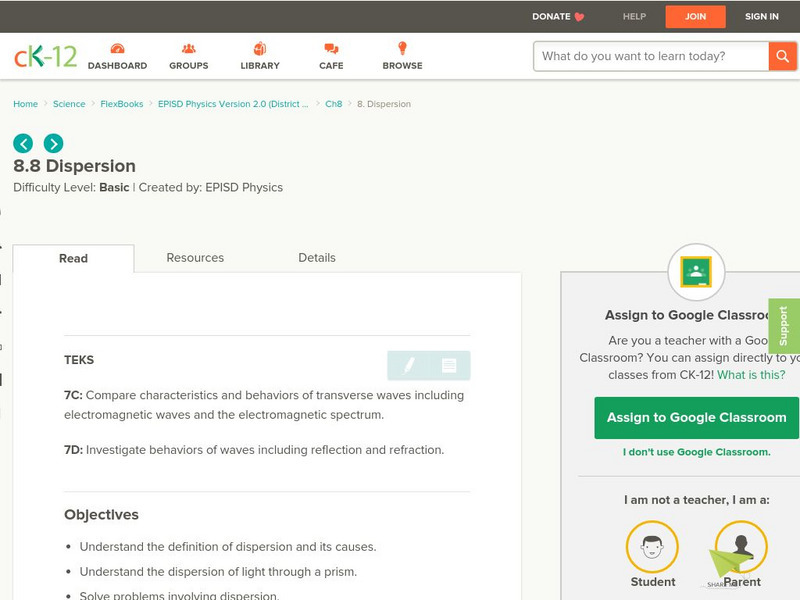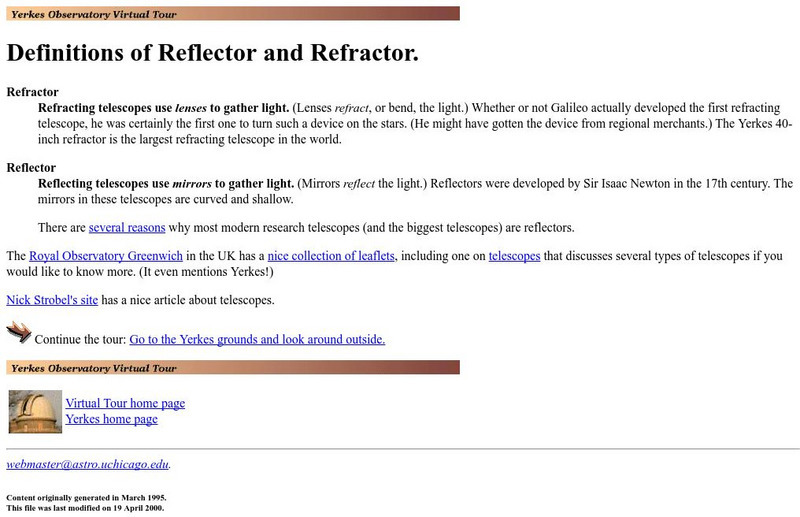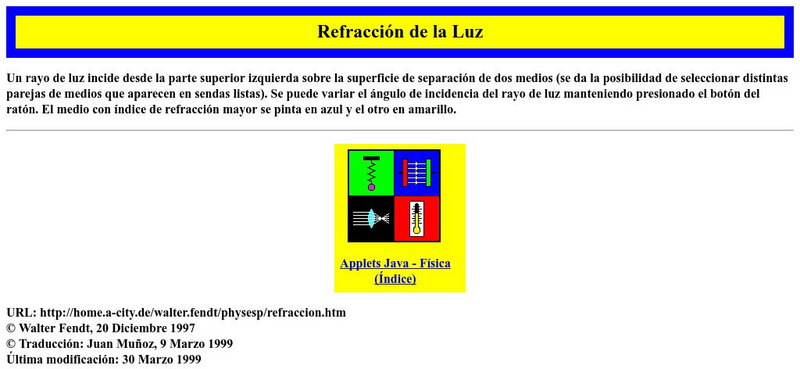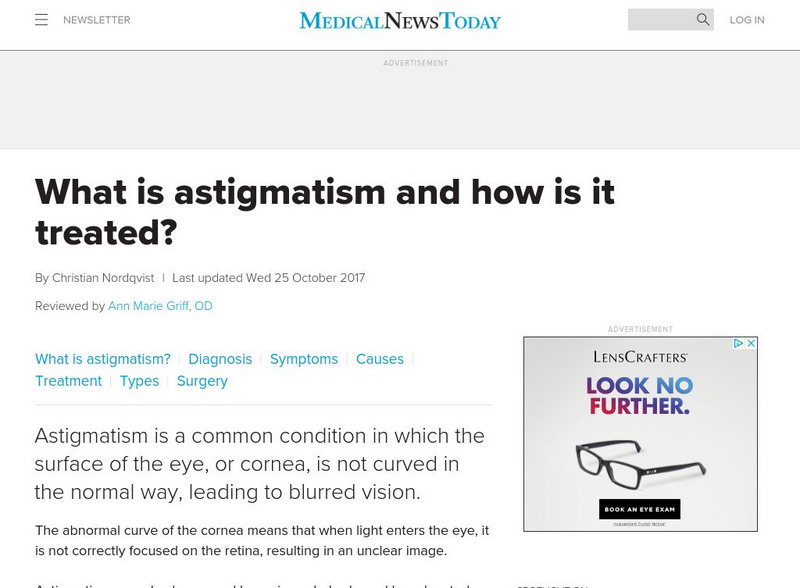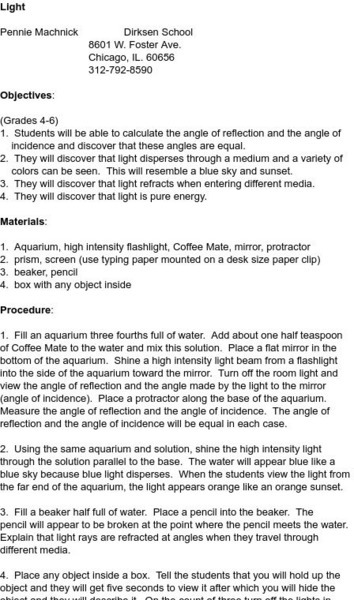Physics Classroom
The Physics Classroom: Refraction and the Ray Model of Light: Anatomy of a Lens
Illustrated diagrams in this tutorial help students understand the properties and functions of lenses.
Physics Classroom
The Physics Classroom: Refraction/ray Model of Light: Image Formation/detection
Students discover the four parts of the eye are the most instrumental in the task of producing images that are discernible by the brain.
Physics Classroom
The Physics Classroom: Refraction/ray Model of Light: Farsightedness/correction
A brief introduction to the physics side of farsightedness, and how lenses correct this vision defect.
Physics Classroom
The Physics Classroom: Refraction/ray Model of Light: Nearsightedness/correction
A brief introduction to the physics side of nearsightedness, and how lenses correct this vision defect.
Physics Classroom
The Physics Classroom: Lesson 3: Concave Mirrors
Lesson 3 of this tutorial on refraction is on concave mirrors. Content that is covered includes the anatomy of curved mirrors, reflection of light and image formation, ray diagrams, image characteristics for concave mirrors, plus more.
Georgia State University
Georgia State University: Hyper Physics: Dispersion
The phenomenon of light dispersion is explained with a formula and a practice form for calculating Abbe's number.
Optical Society
Optical Society of America: Optics for Kids: Total Internal Reflection
An investigation into the total internal reflection of light, using a laser pointer. Accompanied by an explanation of what's happening, a discussion of Snell's Law, and links to additional information.
Khan Academy
Khan Academy: Thin Lens Sign Conventions
Have you ever wondered why some people need glasses and others don't? It's because of the way light is focused by the lens in your eye. This lens, like magnifying glasses, eyeglasses, and contact lenses, is considered a thin lens.
Utah Education Network
Uen: Enlightening Explorations, Part Iii
This lesson plan contains the following labs: Rainbows, Refraction with Prisms, and What Color Is It? Students will study light by reading various nonfiction texts and viewing a video lesson plan. Then students will engage in the...
Utah Education Network
Uen: I'm So Bright! I Wear My Shades Indoors!
This instructional activity engages students in learning about light through multiple sources. Students will learn how light is produced, reflected, refracted, and separated. Students will communicate their findings through an...
Georgia State University
Georgia State University: Hyper Physics: Prisms
This physics department site explains how prisms work and their purpose in the dispersion of light. Explains the angle of deviation and includes an interactive form in which visitors calculate the angle of deviation and receive immediate...
CK-12 Foundation
Ck 12: Dispersion
[Free Registration/Login may be required to access all resource tools.] Students investigate the dispersion of light through a prism and solve practice problems involving this phenomenon.
BBC
Bbc: Gcse Bitesize: General Properties of Waves
Light travels as waves. Waves can be described by their amplitude, wavelength and frequency. The speed of a wave can be calculated from its frequency and wavelength.
Science Education Resource Center at Carleton College
Serc: Mn Step: Why Is the Sky Blue?
Students will learn about refraction and the scattering of sunlight as it enters the atmosphere, which causes the colors in light to separate, giving us blue skies and colorful sunrises and sunsets.
University of Chicago
University of Chicago: Reflector and Refractor
From the Yerkes Observatory Virtual Tour web site. Compares and contrasts reflecting and refracting telescopes. A link from the page leads to a second page which explains why most modern research telescopes are reflecting telescopes.
Optical Society
Optical Society of America: Optics for Kids: Interference in a Ripple Tank
An investigation, using a ripple tank, into how waves behave when they collide with each other. With an explanation of what is observed, and a link to an article on refraction.
York University
The Joy of Visual Perception: Physics of Visual Stimulus
From an online "book," this particular page describes physics principles related to vision and sight. Keywords are linked to other pages with further information. The role of sunglasses in blocking glare is discussed and explained. A...
Other
Walter Fendt: Refraccion De La Luz
Learn about refraction of light with this simulation. This site is best viewed with Internet Explorer.
Exploratorium
Exploratorium: Make Your Own Telescope
At this site students can make their own telescope and see how it works with this experiment. Out of a light, a pair of glasses, a magnifying glass and wax paper.
Healthline Media
Medical News Today: Articles: Eye Health: What Is Astigmatism?
Learn about astigmatism, a type of refractive error where the eye does not bend light properly, thereby causing blurred vision. Also explained are the causes, treatment, and diagnosis of astigmatism.
Florida State University
Florida State University: Science, Optics & You: E Tienne Louis Malus
Biography of Etienne-Louis Malus (1775-1812), a famous French mathematician and physicist, best known for his work in double refraction and in polarization.
Science and Mathematics Initiative for Learning Enhancement (SMILE)
Smile: Light
For this activity, students actually find the angles of reflection and incidence.
Space Telescope Science Institute
Amazing Space: Telescopes From the Ground Up
Students can investigate the historical development of six different telescopes. The technical aspects of different telescopes are also presented.
TED Talks
Ted: Ted Ed: How Do Glasses Help Us See?
Today, glasses help millions of people with poor vision be able to see clearly. But how? Andrew Bastawrous and Clare Gilbert help unravel the answer by explaining refraction- the ability of a transparent medium, like glass, water, or the...
Other popular searches
- Refraction of Light
- Science Light Refraction
- Light Refraction Water
- Lab on Light Refraction
- Reflection Refraction Light
- Prism Light Refraction
- Light Refraction by Prism
- Refraction of Light Mirrors
- Light Refraction Slide
- Science Refraction of Light
- "Refraction" Light
- Science: Refraction of Light

